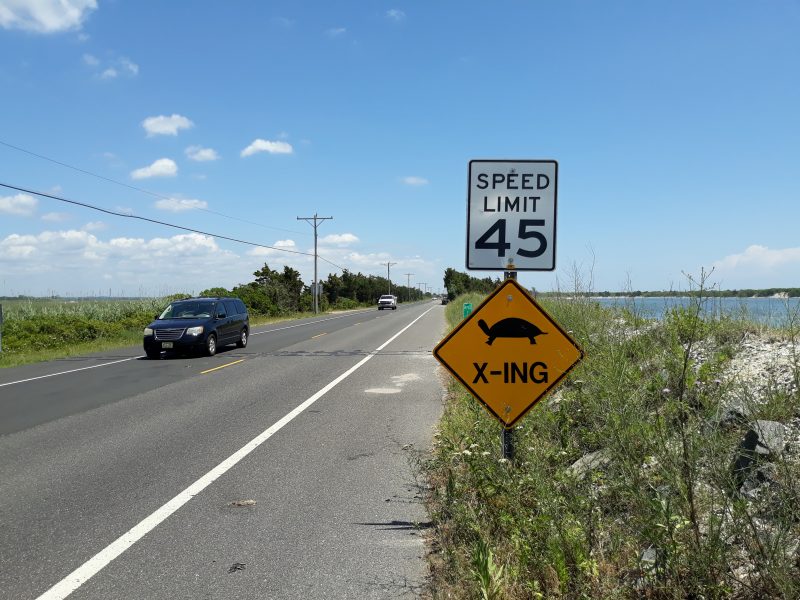Crushed terrapins are along the shoulder of Bay Avenue on the Ocean City side of the Corson's Inlet Bridge.
 By MADDY VITALE
Tiny turtles crawling on the road this time of year are no match for the much faster cars and trucks.
Motorists should be on the lookout as the female diamondback terrapins cross the road to look for areas to lay their eggs.
Steve and Susan Ahern, who run a terrapin rescue organization at the shore, offer a piece of advice to anyone who spots a terrapin in distress or in danger, especially while crossing the roadway.
“You have to help them cross in the direction they are going. They will nest in any place soft enough to dig – even people’s front yards,” Steve Ahern said, noting that no one should put themselves in danger while assisting turtles.
Between Corson’s Inlet Bridge and the Rush Chattin Bridge there is a stretch of Bay Avenue on the Ocean City side littered with crushed turtle carcasses.
Despite bright yellow turtle crossing signs to warn motorists that there may be turtles in the area, travelers may find it difficult to spot the dark, grayish-green coloring of the terrapins that seem to blend in with the black pavement.
By MADDY VITALE
Tiny turtles crawling on the road this time of year are no match for the much faster cars and trucks.
Motorists should be on the lookout as the female diamondback terrapins cross the road to look for areas to lay their eggs.
Steve and Susan Ahern, who run a terrapin rescue organization at the shore, offer a piece of advice to anyone who spots a terrapin in distress or in danger, especially while crossing the roadway.
“You have to help them cross in the direction they are going. They will nest in any place soft enough to dig – even people’s front yards,” Steve Ahern said, noting that no one should put themselves in danger while assisting turtles.
Between Corson’s Inlet Bridge and the Rush Chattin Bridge there is a stretch of Bay Avenue on the Ocean City side littered with crushed turtle carcasses.
Despite bright yellow turtle crossing signs to warn motorists that there may be turtles in the area, travelers may find it difficult to spot the dark, grayish-green coloring of the terrapins that seem to blend in with the black pavement.
 The small, dark turtles are difficult to see on the black asphalt. This one made it safely across the road.
On Sunday, at least a dozen turtles were dead on the shoulder of the roadway along Bay Avenue near the Corson's Inlet Bridge.
Steve Ahern said of the turtle deaths, “They have been out, but concentrated on certain days. Corson’s Inlet has been a real hotspot.”
This year has been one of the latest starts to the diamondback terrapin nesting season, according to the Wetlands Institute in Stone Harbor, which keeps records going back to 1990.
Nesting season for diamondback terrapins is normally from May to July. Females emerge from the marshlands to lay their eggs.
This summer, the turtles did not begin appearing until mid-June. Some experts say it could be due to a cooler beginning to the season, others just aren’t sure.
But the biggest issue now for rescuers such as the Aherns and other turtle experts is how to protect the terrapins on their journey to lay their eggs and then back to the marsh.
Cars, predators and construction will continue to pose dangers to the turtles.
It can take anywhere from eight to 14 weeks for the terrapin eggs to hatch. Since the terrapins, which can live up to 30 years, typically nest in sandy soil, places such as the beaches and dunes give them a safe place to lay their eggs.
The small, dark turtles are difficult to see on the black asphalt. This one made it safely across the road.
On Sunday, at least a dozen turtles were dead on the shoulder of the roadway along Bay Avenue near the Corson's Inlet Bridge.
Steve Ahern said of the turtle deaths, “They have been out, but concentrated on certain days. Corson’s Inlet has been a real hotspot.”
This year has been one of the latest starts to the diamondback terrapin nesting season, according to the Wetlands Institute in Stone Harbor, which keeps records going back to 1990.
Nesting season for diamondback terrapins is normally from May to July. Females emerge from the marshlands to lay their eggs.
This summer, the turtles did not begin appearing until mid-June. Some experts say it could be due to a cooler beginning to the season, others just aren’t sure.
But the biggest issue now for rescuers such as the Aherns and other turtle experts is how to protect the terrapins on their journey to lay their eggs and then back to the marsh.
Cars, predators and construction will continue to pose dangers to the turtles.
It can take anywhere from eight to 14 weeks for the terrapin eggs to hatch. Since the terrapins, which can live up to 30 years, typically nest in sandy soil, places such as the beaches and dunes give them a safe place to lay their eggs.
 Crushed terrapins are along the shoulder of Bay Avenue on the Ocean City side of the Corson's Inlet Bridge.
Crushed terrapins are along the shoulder of Bay Avenue on the Ocean City side of the Corson's Inlet Bridge.